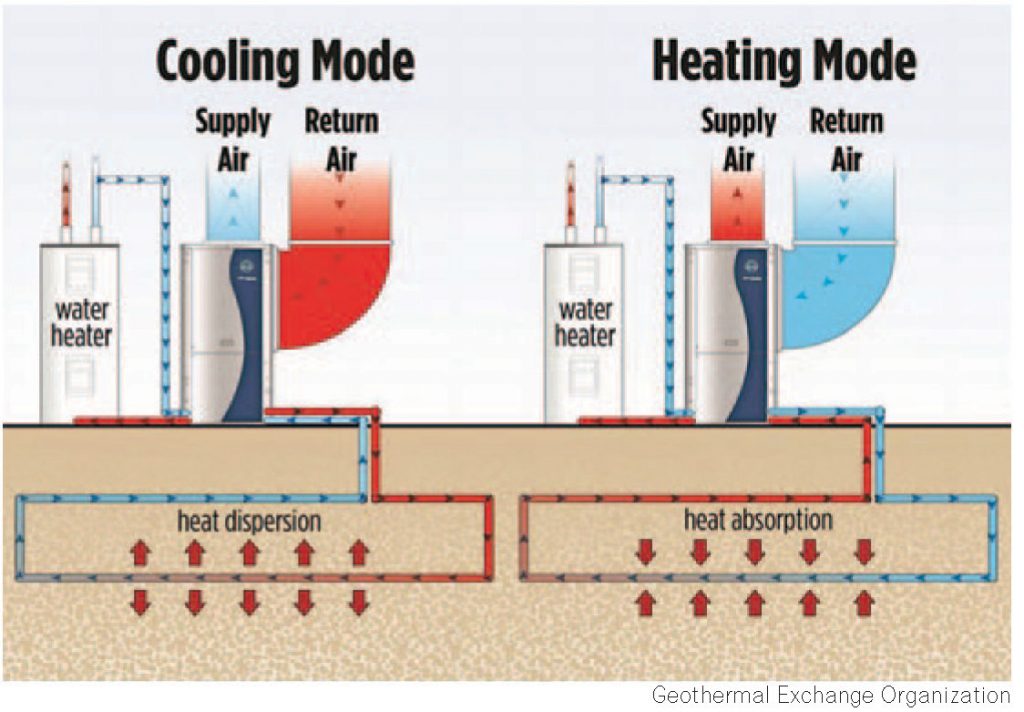A sustainable solution to heating and cooling is right under our feet. But will it pay to ‘Go Geo’ in 2022?
A generation ago, green was a crayon color and sustainable was rarely heard outside a CPA’s office. Nowadays, these words are used to sell products, mobilize activism and promote environmental stewardship. They are flexible, sexy adjectives that pair nicely with more familiar words to create catchy phrases like “going green” and “sustainable energy.” For most homeowners, turning those ideas into meaningful action steps involves junking an ancient HVAC array in favor of a more efficient one. For a forward-thinking few, however, harnessing the constant temperature of the earth to power a geothermal heating and cooling system is the cleaner, greener and more cost-efficient long-term investment.
Traditional HVAC systems (also called air-source heat pumps) pull in the outside air as the exchange medium to regulate indoor temperatures. As we all know, the weather in New Jersey fluctuates throughout the year, so at the extremes of heat and cold, your air-source heat pump has to work harder to keep you comfortable—and puts a bigger dent in your bank account. On the other hand, geothermal heat pumps (GHPs)—alternately referred to as geoexchange, ground-source, earth-coupled or water-source heat pumps—channel the underground temperature into the heating and cooling systems of a home.

Below the frost line in New Jersey, about 4 to 10 feet under the surface, the earth maintains a subterranean temperature of approximately 54° Fahrenheit. With this persistent heat source, geothermal heat pumps can warm your house in the winter, cool your house in the summer, and, if equipped with a desuperheater accessory, even provide hot water to a home—all while using less energy than your standard air-source HVAC.
Geothermal stems from the Greek words “geo” (earth) and “therme” (heat)—heat from the earth. If you’re forming a mental picture of hot springs, deep caves, oceanic vents and molten rock, you’re correct. But, when it comes to a geothermal heat pump in your home, the “geo” in question is, well, dirt.
Modern geothermal technology dates back to the late 19th century, when the world’s first district heating system was implemented in Boise, Idaho. In 1892, Boiseans directed water from the nearby hot springs to provide heat to local establishments. In 1908, homes in Iceland began to use geothermal steam as a heating source; today, 90% of Icelanders use geothermal heat.
During the 20th century, geothermal technology gradually progressed, with innovators constructing geothermal power plants at hot springs and steam fields. In the 1940s, Ohio State University professor Carl Nielsen developed the first residential geothermal heat pump.
From there, however, the technology has done a mostly slow roll. During the energy crisis of the early 1970s, there was a brief spike in interest, but the technology was still wonky and geothermal heat pumps didn’t become popular until a decade or so ago. Now there are roughly 50,000 GHPs installed every year in the US alone.
Can You Dig It?

The first step in installing a geothermal heat pump is to dig a shallow trench and bury a loop of pipes, called a heat exchanger, underground. Once the heat exchanger is in place and connected to the heat pump inside your house, the loop is filled with a fluid, typically a combination of water and antifreeze. During New Jersey winters, the constant underground temperature of 54° is typically warmer than the air aboveground, which averages around 34°. The antifreeze solution in the heat exchanger circulates underground, where it absorbs the earth’s natural heat. The heated solution is then redirected back to the heat pump apparatus in your home, which warms it up another 20° or so and then sends warm air through the ventilation ducts in your house.
During the summer, when New Jersey temps average in the 80s, the same solution in the exchange loop absorbs the heat inside your house, sends the heated solution to lose heat underground and then returns the now-chilled solution to the heat pump to save you from the summer swelter. In this case, heat pump is a bit of a misnomer; the unit is more of an air circulator at this temperature.
When considering a geothermal heat pump, it is helpful to understand your options—for instance, what type of heat exchange loop you want (or need) to install. There are four types of ground-source loops to consider, with three closed-loop options and one open-loop option. Closed-loop systems operate in the same way as I previously described and are the most common type of residential heat exchangers. The three types of closed-loop systems are horizontal loops, vertical loops, and pond/lake loops.
Horizontal loops are typically more cost-effective than other GHP options, because you are digging out into your yard instead of straight down. However, horizontal loops require a decent amount of property to dig the trenches needed for the exchange loop. Once the trenches have been excavated, two pipes are connected and buried—either staggered at 4 and 6 feet deep, or side-by-side at 5 feet deep. Horizontal loops can more easily accommodate difficult geology, like bedrock, since they don’t require deep excavation. Vertical loops are better suited for commercial properties, properties that have limited space or homeowners who wish to minimize soil disturbance. In order to install a vertical loop, holes are drilled two feet apart and down to a depth of 100 feet or more, depending on the residence. Vertical loop installation is the priciest of the GHP options, but it may be necessary for certain properties.
Pond/lake loops make up the last of the popular closed-loop options, and they are a wonderful and relatively inexpensive choice for those with access to a nearby body of water. Pond/lake exchange loops are coiled under at least eight feet of water in order to prevent freezing. This type of system is cost-efficient and effective, however it must meet potentially restrictive criteria regarding the depth, volume, and quality of the water.
The last option is the aforementioned open-loop system. Unlike a closed-loop system, open-loop systems use clean water instead of an antifreeze solution as the heat exchange fluid. This requires a well or an adequate source of clean surface water in order to function properly. As with pond/lake systems, there may be local codes and regulations (for instance, on groundwater discharge) that could inhibit the use of this type of GHP.
Buried Treasure?

There are plenty of reasons to invest in a geothermal heat pump for your home. One of the principal arguments in favor of geothermal heat pumps centers on efficiency. Geoexchange is a remarkably green technology. When it comes to HVAC systems, geothermal heat pumps are the most efficient and the most sustainable. By harnessing the constant underground temperature as a source of heat energy, GHPs are particularly steady and sustainable systems in regards to energy consumption. According to the EPA, geothermal heat pumps use 25 to 50% less energy than standard air-source units and can effectively reduce overall energy usage up to 44%—and up to 72% when compared with standard electrical air-conditioning systems. They can also excel in particularly humid areas by enhancing indoor humidity control. Geothermal heat pumps are also quieter, saving you from the gnawing buzz of traditional systems. GHPs typically run at 40-48 decibels, while standard air-source systems can reach over 70 decibels when they kick on.
Geothermal heat pumps also have a longer lifespan than their traditional counterparts and require less maintenance. While a standard HVAC system has an average lifespan of about 15 years, the geothermal ground loop can last up to 60 years; the average lifespan of the indoor component is almost 25. You can also get a 25-year-or-more warranty for your geothermal heat pump, depending on the installer.
So what’s not to like? Well, installing a ground-source loop on your property requires intense digging and/or drilling, depending on the type of loop you plan to install. Not only can installation of an underground loop temporarily tear up your property, but the actual process can take quite a while. Retrofitting a GHP into your residence can take 6 to 8 weeks to fully complete. New installations in ongoing construction can take even longer, considering all the necessary coordination and scheduling with the other contractors. By comparison, an air-source heat pump typically takes less than a week to install. You also need to be aware of the type of soil your house is sitting on. Dense clay soils are the best option for geothermal heating and cooling systems, followed closely by wet, sandy soils. Dry, sandy soils are the worst option due to poor heat transference, so if this is the soil that you have on your property, your GHP may not function as efficiently.
If you live in heavily forested or (like my family) in earthquake-prone areas, you may want to reconsider buying a geothermal heat pump. Dense forestry means that there are lots of roots that could damage the underground exchange loop. Earthquakes can also be a major threat to your heat exchanger. Not only are repair costs expensive, but the hazards of soil contamination with runaway antifreeze solution can create a small environmental catastrophe.
The Long Game
Purchasing and installing a geothermal system will cost you several times more than a traditional air-source unit. The earth-friendly aspect of GHP ownership may be worth a premium to you, as well it should, but even the most ardent fan of green sustainability may choke a little on the price. So the big question is usually When does it pay for itself?
Let’s start with what we know. If you own a 3,000 square-foot house in New Jersey, purchasing and installing a traditional five-ton HVAC system will cost you around $8,000. Unless you love sauna-like heat in the winter and meat-locker AC in summer, your average annual operating expense for an air-source unit will be around $2,000 give or take. By comparison, a GHP unit serving the same home has an average annual operating cost of just over $800, due to minimal energy consumption.
The return on investment (ROI) in energy savings for a geothermal system typically pays back the upfront cost in 5 to 10 years, depending on a number of variables, but mostly on the initial installation expense—which is where the real damage to your wallet is done.
In 2019, horizontal loop installation fees ranged from $12,000 to $25,000 dollars, while vertical loop installation ran anywhere between $16,000 to $30,000. The total cost of a high-quality GHP in a large home could touch $50,000 in a structure where new ductwork and carpentry was necessary. Still, the ROI seemed reasonable for all the good you might do the planet.
Unfortunately, 2019 was a lifetime ago. The cost of everything—labor, materials, electronics, etc.—shot up during the pandemic. Many homeowners had to put their geothermal dreams on hold when they received the bad news that an additional $10,000 or $15,000 would have to be added to the original estimate. Most folks in the industry believe that this is not the new normal; geothermal project costs should come back into line at some point, hopefully sooner rather than later.
Perhaps infrastructure legislation will help homeowners with the costs. Congress already extended a 26% federal tax credit for geothermal home energy efficiency upgrades until the end of 2022 (it will be reduced to 22% in 2023). Certain municipalities offer an “energy-efficient mortgage,” so you should consult your local banks and mortgage companies for information about that. And geothermal installers usually offer low- or no-interest short-term financing.
To be sure, the financial burden of “Going Geo” is not for everyone. Even in the best of times, with the best of terms, embracing geothermal is a long game. Ten years (or more) is a long time to wait to be made whole. However, if you are deeply concerned about climate change and, especially, if you’re the kind of person who wakes up in a cold sweat wondering how in the world you’ll pay your energy bills in 2030 or 2040, why not let the earth help you out a little?
And do the planet a solid in return. EDGE
Editor’s Note: Caleb Szarabajka is a freelance writer with a degree from Berkeley and a keen interest in earth-friendly tech innovations. For more information on geothermal heating and cooling, visit the Geothermal Exchange Organization web site at geoexchange.org.














